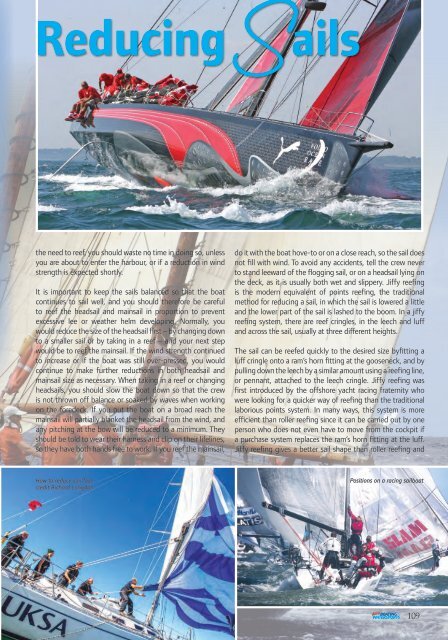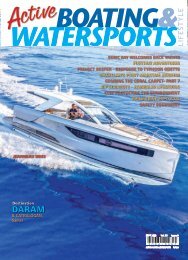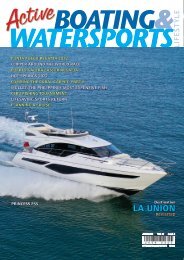ABW March 2024
Create successful ePaper yourself
Turn your PDF publications into a flip-book with our unique Google optimized e-Paper software.
Reducing<br />
the need to reef, you should waste no time in doing so, unless<br />
you are about to enter the harbour, or if a reduction in wind<br />
strength is expected shortly.<br />
It is important to keep the sails balanced so that the boat<br />
continues to sail well, and you should therefore be careful<br />
to reef the headsail and mainsail in proportion to prevent<br />
excessive lee or weather helm developing. Normally, you<br />
would reduce the size of the headsail first – by changing down<br />
to a smaller sail or by taking in a reef – and your next step<br />
would be to reef the mainsail. If the wind strength continued<br />
to increase or if the boat was still over-pressed, you would<br />
continue to make further reductions in both headsail and<br />
mainsail size as necessary. When taking in a reef or changing<br />
headsails, you should slow the boat down so that the crew<br />
is not thrown off balance or soaked by waves when working<br />
on the foredeck. If you put the boat on a broad reach the<br />
mainsail will partially blanket the headsail from the wind, and<br />
any pitching at the bow will be reduced to a minimum. They<br />
should be told to wear their harness and clip on their lifelines,<br />
so they have both hands free to work. If you reef the mainsail,<br />
do it with the boat hove-to or on a close reach, so the sail does<br />
not fill with wind. To avoid any accidents, tell the crew never<br />
to stand leeward of the flogging sail, or on a headsail lying on<br />
the deck, as it is usually both wet and slippery. Jiffy reefing<br />
is the modern equivalent of points reefing, the traditional<br />
method for reducing a sail, in which the sail is lowered a little<br />
and the lower part of the sail is lashed to the boom. In a jiffy<br />
reefing system, there are reef cringles, in the leech and luff<br />
and across the sail, usually at three different heights.<br />
The sail can be reefed quickly to the desired size byfitting a<br />
luff cringle onto a ram’s horn fitting at the gooseneck, and by<br />
pulling down the leech by a similar amount using a reefing line,<br />
or pennant, attached to the leech cringle. Jiffy reefing was<br />
first introduced by the offshore yacht racing fraternity who<br />
were looking for a quicker way of reefing than the traditional<br />
laborious points system. In many ways, this system is more<br />
efficient than roller reefing since it can be carried out by one<br />
person who does not even have to move from the cockpit if<br />
a purchase system replaces the ram’s horn fitting at the luff.<br />
Jiffy reefing gives a better sail shape than roller reefing and<br />
How to reduce sail fast -<br />
credit Richard Langdon<br />
Positions on a racing sailboat<br />
109

















